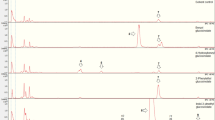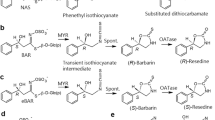Summary
Watercress (Nasturtium officinale) possesses the glucosinolate-myrosinase system. This system is regarded as a classic example of chemical defense for terrestrial crucifers. Damage of watercress initiates myrosinase-mediated hydrolysis of phenylethyl glucosinolate to a toxic endproduct, phenylethyl isothiocyanate. In multiple choice tests, the amphipod Gammarus pseudolimnaeus, the limnephilid caddisflies Hesperophylax designatus and Limnephilus sp., and the physid snail Physella sp. all strongly preferred (10X) yellowed senescent watercress (FY) over fresh green watercress (FG), despite the 2X higher nitrogen content of green watercress (6.9% for FG vs 3.8% for FY). Green watercress contained 10–40 X more glucosinolate than FY watercress (6.4–8.5 mg/g wet for FG vs 0.2–0.7 mg/g wet for FY). However, when the watercress was heated (ca 70°C), to deactivate the myrosinase enzyme, multiple choice tests showed that these species shift their preferences to heated green watercress (HG). Heating deactivated the deterrent effect and overall preference (consumption) was HG ≥ HY > FY ≫ FG for Gammarus. HG > HY ≥ FY ≫ FG for Hesperophylax, HG > FY ≥HY ≥ FG for Limnephilus, and HG ≥ FY > HY ≥ FG for Physella. Thus heating resulted in a shift in preference from the low glucosinolate, but low nitrogen, unheated yellowed tissue to the high nitrogen green tissue. These results suggest that deactivation of the myrosinase enzyme, and hence isothiocyanate production, results in a shift in preference. Preliminary results with Hesperophylax indicate that addition of myrosinase to the test water, which resulted in the formation of isothiocyanate, results in a significant decrease in HG consumption from control levels (p < 0.001) and no change in preference for HY watercress. With Gammarus, myrosinase resulted in reduced consumption of both green and yellowed watercress, but no significant differential effect. These results provide evidence that the glucosinolate-myrosinase system, recognized as the principle deterrent system of terrestrial crucifers, is the feeding deterrent in watercress and also suggest that in the absence of a functioning deterrent system, nitrogen content may influence consumption.
Similar content being viewed by others
References
Blau PA, Feeny P, Contardo L, Robson DS (1978) Allylglucosinolate and herbivorous caterpillars: a contrast in toxicity and tolerance. Science 200: 1296–1298
Blua MJ (1984) Identification and variation of glucocapparin in Isomeris arborea Nutt. Thesis, San Diego State University, San Diego, CA
Blua MJ, Hanscom Z (1986) Isolation and characterization of glucocapparin in Isomeris arborea Nutt. J Chem Ecol 12: 1449–1458
Bodnaryk RP (1991) Developmental profile of sinalbin (p-hydroxybenzyl glucosinolate) in mustard seedling, Sinapis alba L., and its relationship to insect resistance. J Chem Ecol 17: 1543–1556
Bodnaryk RP, Palaniswamy P (1990) Glucosinolate levels in cotyledons of mustard, Brassica juncea L. and rape, B. napus L. do not determine feeding rates of flea beetle, Phyllotreta cruciferae (Goeze). J Chem Ecol 16: 2735–2746
Bowers MD (1988) Chemistry and coevolution: iridoid glycosides, plants and herbivorous insects. In: Spencer KA (ed) Chemical mediation of coevolution. Academic Press, New York, NY, pp 133–165
Center TD, Wright AD (1991) Age and phytochemical composition of waterhyacinth (Pontederiaceae) leaves determine their acceptability to Neochetina eichhorniae (Coleoptera, Curculionidae). Environ Entomol 20: 323–334
Chew FS (1988a) Biological effects of glucosinolates. In: Cutler HG (ed) Biologically active natural products: potential use in agriculture. American Chemical Society, Washington, DC, pp 155–181
Chew FS (1988b) Searching for defensive chemistry in the Cruciferae or do glucosinolates always control interactions of Cruciferae with their potential herbivores and symbionts? No! In: Spencer KA (ed) Chemical mediation of coevolution. Academic Press, New York, NY, pp 81–112
Erickson JM, Feeny P (1974) Sinigrin: a chemical barrier to the black swallowtail butterfly, Papilio polyxenes. Ecology 55: 103–111
Feeny P (1977) Defensive ecology of the cruciferae. Ann Missouri Bot Gard 64: 221–234
Feeny P (1976) Plant apparency and chemical defense. In: Wallace JW, Mansell RL (eds) Biochemical interaction between plants and insects. Recent Advances in Phytochemistry 10. Plenum Press, New York, NY, pp 1–41
Fenwick GR, Heaney RK, Mawson R (1989) Glucosinolates. In: Cheeke PR (ed) Toxicants of plant origin. Vol. II: Glycosides. CRC Press, Boca Raton, FL, pp 1–41
Hay ME, Fenical W (1988) Marine plant-herbivore interactions: the ecology of chemical defense. Annu Rev Ecol Syst 19: 111–145
Hoimlund MB, Peterson CH, Hay ME (1990) Does algal morphology affect amphipod susceptibility to fish predation? J Exp Mar Biol Ecol 139: 65–83
Jeffries M (1990) Evidence of induced plant defences in a pondweed. Freshwat Biol 23: 265–269
Kerfoot WC (1989) Glucosinolates and phenolics in aquatic macrophytes: implications for allelopathy studies and suggested practical uses for metabolic blocking agents. In: Proc 23rd Annual Meeting of the Aquatic Plant Control Research Prog Misc Paper A-89-1, Waterways Experiment Station, Vicksburg, MS, pp 178–189
Lichtenstein EP, Morgan DG, Mueller CH (1964) Naturally occurring insecticides in cruciferous crops. J Agric Food Chem 12: 158–161
Lichtenstein EP, Strong FM, Morgan DG (1962) Identification of 2-phenylethylisothiocyanate as an insecticide occurring naturally in the edible part of turnips. J Agric Food Chem 10: 30–33
Lodge DM (1991) Herbivory on freshwater macrophytes. Aquat Bot 41: 195–224
Louda SM, Rodman JE (1983) Ecological patterns in the glucosinolate content of a native mustard, Cardamine cordifolia, in the Rocky Mountains. J Chem Ecol 9: 397–422
Malicky H (1990) Feeding tests with caddis larvae (Insecta, Trichoptera) and amphipods (Crustacea, Amphipoda) on Platanus orientalis (Platanaceae) and other leaf litter. Hydrobiologia 206: 163–173
McClure JW (1970) Secondary constituents of aquatic angiosperms. In: Harborne JB (ed) Phytochemical Phylogeny. Academic Press, New York, pp 233–268
Newman RM (1991) Herbivory and detritivory on freshwater macrophytes by invertebrates: a review. J N Am Benthol Soc 10: 89–114
Newman RM, Kerfoot WC, Hanscom Z (1990) Watercress and amphipods: potential chemical defense in a spring stream macrophyte. J Chem Ecol 16: 245–259
Newman RM, Kerfoot WC, Hanscom Z (1992) Consumption of watercress by aquatic invertebrates and its effect on their growth and survival. Unpublished Manuscript
Ostrofsky ML, Zettler ER (1986) Chemical defences in aquatic plants. J Ecol 74: 279–287
Otto C, Svensson BS (1981) How do macrophytes growing in or close to water reduce their consumption by aquatic herbivores? Hydrobiologia 78: 107–112
Peterson CH, Renaud PE (1989) Analysis of feeding preference experiments. Oecologia 80: 82–86
Renwick JAA (1988) Comparative mechanisms of host selection by nsects attacking pine trees and crucifers. In: Spencer KA (ed) Chemical mediation of coevolution. Academic Press, New York, NY, pp 303–316
Suren AM (1989) Histological changes in macrophyte tissue during decomposition. Aquat Bot 33: 27–40
Suren AM, Lake PS (1989) Edibility of fresh and decomposing macrophytes to three species of freshwater invertebrate herbivores. Hydrobiologia 178: 165–178
Thangstad OP, Evjen K, Bones A (1991) Immunogold-EM localization of myrosinase in Brassicaceae. Protoplasma 161: 85–93
Wilkinson L (1989) SYSTAT: the system for statistics. SYSTAT Inc, Evanston, IL
Author information
Authors and Affiliations
Rights and permissions
About this article
Cite this article
Newman, R.M., Hanscom, Z. & Kerfoot, W.C. The watercress glucosinolate-myrosinase system: a feeding deterrent to caddisflies, snails and amphipods. Oecologia 92, 1–7 (1992). https://doi.org/10.1007/BF00317255
Received:
Accepted:
Issue Date:
DOI: https://doi.org/10.1007/BF00317255




